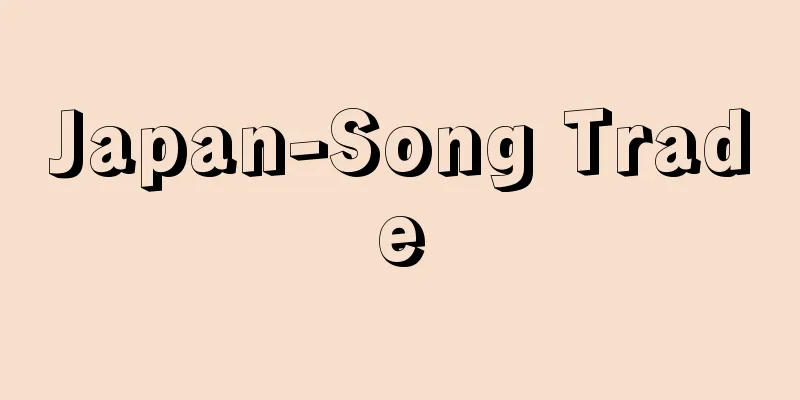Japan-Song Trade

|
Trade took place between Japan and the Northern Song and Southern Song dynasties of China from the late 10th century to the late 13th century. Stimulated by the vigorous commercial activities of Arabian merchants, Chinese overseas development began around the 7th and 8th centuries in the South China Sea region, centered around Guangzhou. From the mid-9th century, Tang dynasty maritime merchants appeared, bringing to Japan the specialty products of Southeast Asia they had acquired through South China Sea trade. After the turbulent period of the Five Dynasties at the end of the Tang Dynasty, China was reunified under the Song Dynasty. With the stability of public order, the development of various domestic industries, and the revival of trade with the South Seas, Song merchants' voyages to Japan far surpassed those of the Tang Dynasty. Song merchants were well acquainted with the monsoons and ocean currents of the East China Sea, and could make voyages between Japan and Song in five to seven days one way. They would usually arrive in Japan on the southwest winds in May and June, and return on the northeast winds in March and April of the following year. In the early period (late 10th century to early 12th century), Hakata was the trading center, and trade was conducted under the control of Dazaifu. Song merchants carried a travel document called "kohyo" (a document detailing the merchant's status, the cargo carried, and the purpose of the visit. It was issued by the Shihakushi, a trade supervision agency in Mingzhou, which had opened its port to trade with Goryeo and Japan), and based on this document, the imperial court's Chinese goods trade envoys dispatched to Dazaifu exercised the right of first refusal, after which general trade was permitted. Later, Dazaifu officials began to exercise the right of first refusal based on a list from the imperial court, and Dazaifu's trade control was strengthened. Song merchants, who disliked this, began to dock at ports in the manors of powerful temples and shrines, where they had obtained the right of non-entry, and to conduct private trade. As a result, trade expanded to a wide area centered on the west coast of Kyushu, stretching from Hakata to Satsuma, and lawsuits between Dazaifu and manor lords over trade control became frequent. In the later period (late 12th century to late 13th century), the Taira clan government was established on the Japanese side, and new developments were opened up, such as the construction of Owada no Tomari, which allowed Song merchant ships to enter the Seto Inland Sea and conduct trade. The Kamakura shogunate that followed also actively participated in trade with the Song, and it seems that Song merchant ships arrived at Kamakura's outer ports of Wakae (Iijimanotsu) and Mutsura. In this environment, many Japanese began to travel to Song. It is said that as many as 40 to 50 Japanese ships traveled to Southern Song per year. Both the Northern Song and Southern Song dynasties were consistently active in trade with Japan, but after 1127 they sought financial resources from trade to compete with the Jin dynasty, which ruled northern China. This, combined with Japan's increasingly aggressive foreign policy, led to an unprecedented boom in Japan-Song trade. Through Japan-Song trade, the Song imported spices, ceramics, books, birds and animals from the South Seas, medicines, copper coins, and other goods known as "karamono," while Japan exported swords, mercury, sulfur, timber, gold dust, etc. In particular, the copper coins, the latest architectural and civil engineering technology, and Zen Buddhism imported through Japan-Song trade had a tremendous impact on various areas of Japanese society, economy, and culture. [Yokoi Shigeyuki] "Study on the History of East-West Negotiations: The South Seas Edition" by Fujita Toyohachi (1932, Oka Shoten)" ▽ "The Traditions of Pu Shougen" (included in the Complete Works of Kuwahara Jitzo, Volume 5, 1968, Iwanami Shoten)" ▽ "The History of Gold and Coin Exchange between Japan and the Song Dynasty" by Sogabe Shizuo (1949, Hobunkan)" ▽ "Selected Works of Mori Katsumi 1-4" (1975, Kokusho Kankokai)" ▽ "Zhang Xiangyi, 'The Current State and Issues of Research on Ship Trade in the Song Dynasty'" (included in the Bulletin of the Faculty of Liberal Arts, Asia University, Vol. 24, 1982, Asia University) Source: Shogakukan Encyclopedia Nipponica About Encyclopedia Nipponica Information | Legend |
|
10世紀後半~13世紀後半の間、日本と中国の北宋(ほくそう)・南宋(なんそう)との間で行われた貿易。中国人の海外発展は7~8世紀ごろよりアラビア商人の活発な通商活動に刺激されて、広州(こうしゅう)を中心とする南海方面を舞台に始まった。9世紀中葉からは、南海貿易で得た東南アジアの特産品を日本へももたらす唐(とう)の海商が現れた。 唐末五代の混乱期を経て宋朝の中国再統一がなると、治安の安定、国内諸産業の発展、南海貿易の復興などによって、宋海商の日本来航は唐代をはるかにしのぐようになった。宋海商らは、東シナ海のモンスーン・海流を熟知し、日宋間を片道5~7日で航海した。彼らは、5、6月の西南風に乗って来日し、翌年3、4月の東北風を利用して帰航するのが通例であった。 前期(10世紀後半~12世紀前半)には、博多(はかた)を交易の場とし、大宰府(だざいふ)の統制の下に交易が行われた。宋海商が携帯する渡航証である「公凭(こうひょう)」(商人の身分、積載貨物の内容、来航目的などを記載。高麗(こうらい)・日本との貿易のために開港した明州の貿易監督機関である市舶司(しはくし)が発給した)を基に大宰府に派遣された朝廷の唐物(からもの)交易使が先買権を行使し、その後に一般の交易が許されるという形態をとった。のち、朝廷からの目録を基に大宰府官吏が先買権を行使するようになり、大宰府の貿易管理が強化されたため、これを嫌う宋海商らは不入権を獲得した権門寺社領の荘園(しょうえん)内の港湾に着岸して私貿易を行うようになった。このため、九州西岸を中心として博多から薩摩(さつま)に至る広い地域に交易の場は拡大し、貿易統制権をめぐって大宰府と荘園領主との訴訟が頻発した。 後期(12世紀後半~13世紀後半)には、日本側に平氏政権が成立し、大輪田泊(おおわだのとまり)を修築して宋商船を瀬戸内海へ引き入れて貿易を行うなど新たな局面が切り開かれた。続く鎌倉幕府も基本的に対宋貿易には積極的に関与し、鎌倉の外港和賀江(わかえ)(飯島津(いいじまのつ))、六浦(むつら)にも宋商船の来航があったようである。こうしたなかで、日本人で宋に渡航する者が輩出した。南宋に渡る日本船は、1年に40~50艘(そう)に及んだといわれる。北宋・南宋ともに一貫して対日貿易には積極的だったが、1127年以後、華北を支配する金(きん)と対抗する財源を貿易の利に求めたため、日本側の対外政策の積極化と相まって日宋貿易は空前の活況を呈した。 日宋貿易を通じて、宋側からは「唐物」といわれる香料・陶磁器・書籍・南海産の鳥獣・医薬品・銅銭などが輸入され、日本からは刀剣・水銀・硫黄(いおう)・木材・砂金などが輸出された。とくに日宋貿易を通じて輸入された銅銭、最新の建築・土木技術、禅宗は日本の社会経済・文化の諸分野に多大な影響を与えた。 [横井成行] 『藤田豊八著『東西交渉史研究 南海篇』(1932・岡書店)』▽『『蒲寿庚の事蹟』(『桑原隲蔵全集 第五巻』所収・1968・岩波書店)』▽『曽我部静雄著『日宋金貨幣交流史』(1949・宝文館)』▽『『森克己著作選集1~4』(1975・国書刊行会)』▽『張祥義「宋代市舶司貿易研究の現状と課題」(『亜細亜大学教養部紀要』24所収・1982・亜細亜大学)』 出典 小学館 日本大百科全書(ニッポニカ)日本大百科全書(ニッポニカ)について 情報 | 凡例 |
<<: Treaty on Basic Relations between Japan and the Soviet Union
>>: Nisso Conglomerate - Nisso Conglomerate
Recommend
Strong flour - Kyorikiko
This flour is made by milling hard wheat such as ...
Toru Takemitsu
Composer. Born in Tokyo. Apart from a brief perio...
Kamedayu Shinto Ritual - Kameyu Shinto Ritual
…Regular festival is held on October 14th. Specia...
Kanoko Shibori
A tie-dye that resembles the white spots on a deer...
Cutting - Cutting
It is a method used to propagate plants, in which...
Kanjoshin - Invitation deity
...Originally a Buddhist term, it was used to mea...
Kannon Bodhisattva - Kanzeonbosatsu
A representative bodhisattva of Mahayana Buddhism...
Muromachi Shogunate
A military government led by the Ashikaga clan. I...
Pale thrush (white belly)
A passerine bird of the family Flycatcher (illustr...
Kuruwa writings - Kuruwa writings
A joruri gidayu-bushi (play of the chanting of th...
Monticelli - Adolphe Joseph Thomas Monticelli
French painter. Born and died in Marseille. At th...
yakṣa (English spelling) yaksa
…This goddess later becomes the protector of chil...
Commonwealth Broadcasting Association
…The headquarters is in London. The Commonwealth ...
Donellus, H. (English spelling) DonellusH
…French jurist. Latin name Hugo Donellus. Born in...
Schrebergärten (English spelling)
...For example, the Russian dacha is a small vill...









